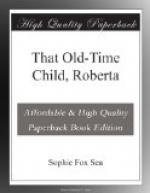A giant’s great glittering eye she called that; the trees on the hills above the giant’s brows, and the ferns and grasses growing on either bank were upper and lower lashes. With a little encouragement Roberta would have been a genuine poet.
But Aunt Betsy took such a literal view of things, she was constantly saying to Mrs. Marsden:
“That child’s imagination will get away with her, Julia, if you don’t check it. It will, indeed.”
And she had a way of making the child repeat over and over again descriptions of things that had struck her fancy, and cutting here and there until the description didn’t seem applicable at all to the places she had seen.
“I feel just like the old woman in Mother Goose, Auntie,” Roberta would say, her eyes full of vexed tears, “when she woke up on the king’s highway and found her petticoats were cut off.”
“But truth is truth, child,” said Aunt Betsy.
Aunt Betsy’s intensely realistic temperament could not understand that fine, exquisite perception God had given the little girl, which enabled her to see beauty that others, differently organized, would never see, nor, believe was there.
The house, where four generations of Mrs. Marsden’s family had lived, was home-like, but quaint and unpretentious. It had a very solid look and was in thorough repair, for the family were thrifty and well-to-do always. Luxuriant vines of the Virginia creeper grew on the sides of the house and around the pillars of the porches. Wandering tendrils hung from the eaves and crept in the second-story windows. There was a wild-brier rose there that had been planted by Mrs. Marsden’s grandmother. It partook somewhat of the nature of the old lady; nothing could keep it from doing its duty. It filled the air with fragrance in its season, and was a mass of delicate pink flower cups.
Inside of the old house were many little nooks, and each nook haunted by the spirit of some legendary story. As is the case in all houses where successive generations of the same family have lived and died, ghostly visitants came at certain times, so the negroes said, rang bells softly at dead of night, tipped across the floor with but the echo of a step, jostled medicine bottles together and did many curious things. Roberta, brave as she was and sensible as she was, would actually cover up her head with the bedclothes, and nearly smother for fear she would hear the bells and ghostly steps.
Mam’ Sara was the only one of the negroes who didn’t believe in ghosts. “No, indeed, honey,” she would say to Roberta, “daid fo’ks don’ never cum bak. If they gits ter Heaven, they don’ wan’er, and if they gits ter de udder place they can’t. The devil won’ never let ’em git away frum him, kase he’s wuk so hard ter git ’em.”
The part of the house of most interest to Roberta was the parlor, where were stored the heir-looms of the family, a spinet with all the ivory worn off the keys, two pier-glasses with brass claws for feet, and a clock so tall and big she actually hid in it once when she was playing “hide and go seek” with some little visitors, who said they had seen a clock “larger.”




